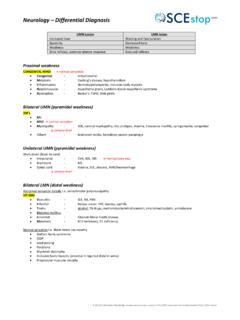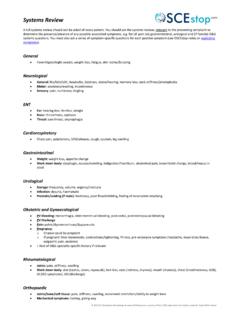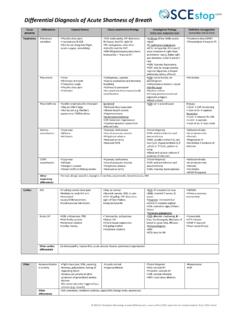Transcription of Joint Aspiration/Corticosteroid Injection - OSCEstop
1 2016 Dr Christopher Mansbridge at , a source of free OSCE exam notes for medical students finals OSCE revision Joint sizes Large = knee, ankle, shoulder Medium = wrist, elbow Small = MCP, ICP, sternoclavicular, acromioclavicular Joint Aspiration/Corticosteroid Injection aspiration indications: diagnose cause of swollen Joint ; tense effusion symptom relief Steroid Injection indications: osteoarthritis, synovitis, inflammatory arthritis, crystalloid arthropathies, tendinopathy (except achilles/patellar), bursitis, entrapment syndromes Relative contraindications: overlying cellulitis (IV antibiotics required); coagulopathy (INR > , platelets <50, therapeutic anticoagulant <24 hours, clopidogrel <7days); skin lesion over Joint ; known bacteraemia; adjacent osteomyelitis; Joint prosthesis Introduction Wash hands, Introduce self, Patients name & DOB, Explain procedure and get consentoRisks: pain, bleeding/haemarthrosis, infection, cartilage damage, damage to local structuresoCorticosteroid risks: tendon atrophy/rupture, avascular necrosis, skin discoloration, local fat atrophy, softtissue/pericapsular calcification, osteoporosis **Check patients clotting screen, platelet count and if they have been on an therapeutic anticoagulant/clopidogrel** Check drug allergies Ensure assistant is available Examine Joint and confirm effusion Preparation part Wash hands and apply apron Clean a trolley Gather equipment onto bottom of trolley (think through what you need in order)oSterile packoCleansing snap-sponge (iodine or alcohol/chlorhexidine) x2oOPTIONAL.
2 Sterile drape with hole in centre (or 2-3 drapes without holes in)o10ml syringe and 2 needles (1 orange 25G, 1 green 21G) for local anaestheticoInjection/ aspiration needle (green 21G if large Joint , blue 23G needle if medium Joint , orange 25G if small Joint )oSyringe 20-50ml syringe if doing aspiration (depending on size of effusion) 1-5ml syringe if doing Injection (5ml for large Joint , for medium Joint , 1ml for small Joint )oExtra green 21G needle to draw up steroid if doing aspirationoCotton gauze swabs (used whenever needed throughout procedure to dry/clean sterile area)oSterile dressingoEquipment to be kept outside of the sterile field Incontinence pad Sterile gloves 10ml 1% lidocaine (maximum 3mg/kg note 1ml 1% lidocaine = 10mg) 2 white-topped sample collection bottles, 1 yellow SST tube and 1 purple EDTA tube if doing aspiration 80mg Depo-Medrone (methylprednisolone acetate) in 2ml vial if doing large Joint Injection 40mg Depo-Medrone (methylprednisolone acetate) in 1ml vial if doing medium/small Joint Injection Walk to patient Wash hands Open sterile pack to form a sterile field on the top of the trolley Open packets (without touching the instruments themselves)
3 And drop sterile instruments neatly into the sterile field Pick up waste bag from sterile pack without touching anything else and stick to side of trolleyPatient part Positioning and exposure Position patient Expose Joint and place incontinence pad below Examine the surface anatomy of patient s Joint Locate insertion point Mark insertion point with a skin pen/indentationPreparation Wash hands Apply sterile gloves using sterile technique (open pack on a side surface) Sterilize areaoWork from middle outwards in one spiral motion (using cleansing snap-sponge)oRepeat with second cleansing snap-spongeoDiscard used snap-sponges as they are no longer sterile, but note all equipment used after this (including all needles)can be returned to the sterile field after use 2016 Dr Christopher Mansbridge at , a source of free OSCE exam notes for medical students finals OSCE revision o OPTIONAL.
4 Apply the sterile drape over the patient s body so that the hole is in the correct place to allow access to the insertion site (or apply 2-3 drapes centred around exposed insertion site if no holes) Anaesthetise tract o Ask assistant to snap open lidocaine bottle and hold open upside-down o Draw up lidocaine using 1st green needle on 10 ml syringe and expel any air (maximum 7ml if doing Injection so the rest can be used with the Injection ) o Change to the orange needle and insert at an acute angle to form a single subcutaneous bleb around insertion site in order to anaesthetise the skin o Now use the same needle to anaesthetise the insertion tract up to the Joint capsule Always aspirate when advancing the needle (so you know if you enter the Joint capsule) and aspirate before injecting lidocaine (to check you are not in a vessel) Joint aspiration With a 20-50ml syringe on the aspiration needle, stretch the skin and insert into the insertion tract Aspirate during infiltration As soon as fluid enters the syringe, stop advancing the needle and aspirate to fill the syringe/as much as possible Withdraw the needle Joint Injection Ask assistant to snap open Depo-Medrone bottle and hold this and the lidocaine bottle open upside-down Draw up the Depo-Medrone and some lidocaine into the same syringe using a green needle and expel any air o Large Joint : 2ml Depo-Medrone + 3ml lidocaine (in 5ml syringe) o Medium Joint : 1ml Depo-Medrone + 1ml lidocaine (in syringe) o Small Joint .
5 Depo-Medrone + lidocaine (in 1ml syringe) Change to the Injection needle, stretch the skin and insert into the insertion tract Aspirate during infiltration When in place, aspirate to ensure you are not in a vessel and slowly expel the contents of the syringe Withdraw needle Finally Dress wound Joint specific techniques Knee Suprapatellar approach o Position patient lying supine with the knee extended o Identify the midpoint of the superolateral border of the patella o Insert needle 1cm above and 1cm lateral to this point o Direct the needle inferomedially and angle slightly posteriorly (at ~ 45 from horizontal plane), between the posterior surface of the patella and the intercondylar femoral notch Parapatellar approach (preferred aspiration approach) o Position patient lying supine with the knee extended o Identify the junction of the upper and middle third of the patella on its medial or lateral border o Apply pressure to the opposite border of the patella to open the Joint space o Palpate the groove under the patella (~5-10mm laterally)
6 And insert the needle here o Direct the needle medially and a little inferiorly in the horizontal plane, between the posterior surface of the patella and the intercondylar femoral notch Infrapatellar approach o Position patient sitting on the side of the bed with knees at 90 over side o Identify the inferior border of the patella and the patella tendon o Insert the needle 5mm inferior to the inferior border of the patella, just lateral to the patella tendon o Direct the needle superomedially and angle slightly posteriorly (at ~ 45 from horizontal), between the posterior surface of the patella and the intercondylar femoral notch Note: lateral approaches are described above but identical medial approaches may also be used Shoulder Anterior approach (preferred) o Position the patient in a seated position with their shoulder externally rotated o Palpate the coracoid from anteriorly o Insert the needle 1cm lateral to the coracoid (medial to head of humerus) o Direct the needle posteriorly and angle slightly superolaterally Posterior approach o From posteriorly, palpate the acromium (posteriorly) and coracoid (anteriorly)
7 O Insert the needle 1cm inferior to the posterior tip of the acromium o Direct the needle anteriorly and angle slightly medially towards the coracoid 2016 Dr Christopher Mansbridge at , a source of free OSCE exam notes for medical students finals OSCE revision Wrist Position the patients forearm on a stable surface, with their palm facing downwards Ask the patient to extend their thumb to identify the extensor pollicis longus tendon, and also locate Lister s tubercle (bony prominence at distal end of radius) Insert the needle distal the Lister s tubercle and lateral to extensor pollicis longus tendon Direct the needle ventrally, perpendicular to the forearm Elbow Position the patients elbow at 90 flexion, rested on a stable surface Palpate the olecranon process, the lateral epicondyle and the radial head Insert the needle the centre point of this triangle, perpendicular to the skin Ankle Anterolateral approach (preferred) o Position the patient lying supine with ankle at 90 o Palpate the space between the lateral malleolus (laterally) and the extensor digitorum longus (medially) in the ankle Joint line o Insert the needle midway between o Aim the needle posteriorly, perpendicular to the fibular shaft Anteromedial approach (risks damage to dorsalis pedis and deep peroneal nerves)
8 O Position the patient lying supine with ankle at 90 o Palpate the space between the medial malleolus (medially) and the tibialis anterior tendon (laterally) in the ankle Joint line (just above the talus) o Insert the needle midway between o Aim the needle posteriorly and slightly laterally, perpendicular to the tibial shaft Note: you can ask patient to dorsiflex foot against resistance to help identify tendons Metacarpophalangeal Joint Rest the hand on a stable surface, palm down with the fingers slightly flexed Insert the needle dorsally, either medial or lateral to the extensor tendons To complete Thank patient and cover them Bin waste and gloves, dispose of sharps safely in sharps bin, clean trolley and wash hands If required, label sample tubes and send to lab: o White sample tube MC&S microbiology o Green sodium heparin tube crystals biochemistry o Purple EDTA tube cell count haematology Note: septic Joint WCC = >50,000 cells/ L (>75% polymorphs) Fully document procedure in patients notes



